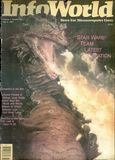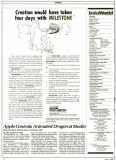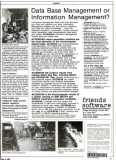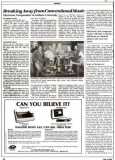Microcomputers are winding their way into some of the most interesting applications. Even the dragons of old are being improved by a healthy dose of microelectronics.
For a new Paramount/Disney production, Dragonslayer, a special-effects studio has developed a new type of animation using an Apple II computer, creating a lifelike effect that is unparalleled in the industry. The studio is Industrial Light and Magic (ILM), a division of Lucasfilm, Ltd., in San Rafael, California, famous for the effects in Star Wars and The Empire Strikes Back.
"We call the new technique 'Go/Mo’,” .said Dennis Muren, director of special effects for ILM. "The dragon is fully motion-controlled by the Apple II. By coordinating its motion with the camera we can film detailed movements that can be repeated very accurately.”
This technique is used extensively in the dragon’s walking scenes. The Go/Mo technique also allows the filming of actual movement, contributing greatly to the dragon's realism. In more traditional animation techniques, the animation model is moved by hand and filmed one frame at a time. Film the model, move the model, film, move, etc. When the film runs at a higher speed, the model looks like it is moving. An example of this approach is the original King Kong. The image does not quite look "real” and the movement looks stilted. Thousands of individual pictures create the illusion of movement. Several days of creating animated motion may result in three seconds of on-screen action.
With Go/Mo, the computer easily accomplishes repetitive movements, eliminating those thousands of hand adjustments. The camera films each frame as the computer moves the model, creating a slight blur on each frame. The opening of the camera shutter is symchronized with the motion of the model. This creates the natural blur we see when watching movement in films. It contributes to the naturalness of filmed animation movement by creating a fluid sense of motion.
Apple as Puppeteer
The Apple II interfaced with a digital-to-analog converter, controls both the camera controller and 16 accurate stepper motors that are connected by rods to the various limbs of the dragon. Almost any movement can be created within the axis and degrees of freedom of the stepper motor configuration.
ILM has hired some of the best special-effects people in the world to evolve these new techniques. Dennis Muren’s team, for example, recently won an Oscar for the special effects in The Empire Strikes Back.
"I've been playing with special effects since I was 12,” said Muren. "I was fascinated by the special effects in films like King Kong and The Thief of Bagdad"
Muren’s first commercial experiences with special effects were in TV commercials – the Pillsbury Doughboy and the Jolly Green Giant. He then made his own film called EquinoiL and went on to what he calls his “space education.” This included the model work in Flesh Gordon, Star Wars, Battlestar Galactica and The Empire Strikes Back. He then became the overseer of the special effects in Dragonslayer.
"Technically, making a dragon is the same as making a spaceship. The real challenge, however, was applying this new movement technology to an animal figure – much more complex than the movement of a spaceship,” said Muren.
Muren foresees the application of this special-effects technology throughout the film industry. Besides space films, fantasy films will find much use for the technology.
Industrial Light and Magic has developed a dedicated-microprocessor control system to replace the Apple II in future Go/Mo applications. "The Apple is more sofistikated than our needs,” said Gary Leo, programmer and technical consultant for Lucasfilms. "It played a valuable role in teaching us what parameters to use when creating Go/Mo. Now that we know specifically what we want, we can build dedicated equipment to fill our needs."
The Go/Mo technique is but one of many new techniques the Lucasfilms people are designing. Other areas of research and development include computer graphics, new camera designs, electronically-controlled camera tracking equipment and new editing techniques. Like just about every other industry, the film industry is feeling the effects of the micro revolution.



